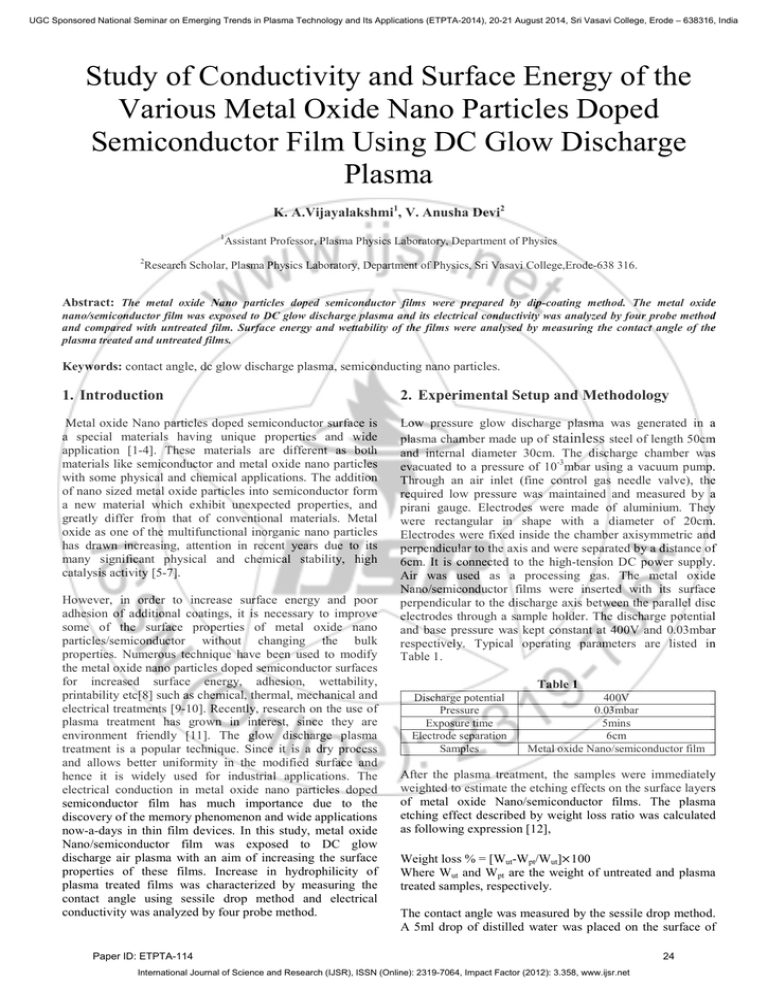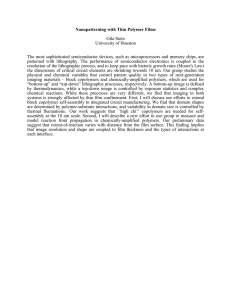Study of Conductivity and Surface Energy of the Various Metal Oxide
advertisement

UGC Sponsored National Seminar on Emerging Trends in Plasma Technology and Its Applications (ETPTA-2014), 20-21 August 2014, Sri Vasavi College, Erode – 638316, India Study of Conductivity and Surface Energy of the Various Metal Oxide Nano Particles Doped Semiconductor Film Using DC Glow Discharge Plasma K. A.Vijayalakshmi1, V. Anusha Devi2 1 Assistant Professor, Plasma Physics Laboratory, Department of Physics 2 Research Scholar, Plasma Physics Laboratory, Department of Physics, Sri Vasavi College,Erode-638 316. Abstract: The metal oxide Nano particles doped semiconductor films were prepared by dip-coating method. The metal oxide nano/semiconductor film was exposed to DC glow discharge plasma and its electrical conductivity was analyzed by four probe method and compared with untreated film. Surface energy and wettability of the films were analysed by measuring the contact angle of the plasma treated and untreated films. Keywords: contact angle, dc glow discharge plasma, semiconducting nano particles. 1. Introduction 2. Experimental Setup and Methodology Metal oxide Nano particles doped semiconductor surface is a special materials having unique properties and wide application [1-4]. These materials are different as both materials like semiconductor and metal oxide nano particles with some physical and chemical applications. The addition of nano sized metal oxide particles into semiconductor form a new material which exhibit unexpected properties, and greatly differ from that of conventional materials. Metal oxide as one of the multifunctional inorganic nano particles has drawn increasing, attention in recent years due to its many significant physical and chemical stability, high catalysis activity [5-7]. Low pressure glow discharge plasma was generated in a plasma chamber made up of stainless steel of length 50cm and internal diameter 30cm. The discharge chamber was evacuated to a pressure of 10-3mbar using a vacuum pump. Through an air inlet (fine control gas needle valve), the required low pressure was maintained and measured by a pirani gauge. Electrodes were made of aluminium. They were rectangular in shape with a diameter of 20cm. Electrodes were fixed inside the chamber axisymmetric and perpendicular to the axis and were separated by a distance of 6cm. It is connected to the high-tension DC power supply. Air was used as a processing gas. The metal oxide Nano/semiconductor films were inserted with its surface perpendicular to the discharge axis between the parallel disc electrodes through a sample holder. The discharge potential and base pressure was kept constant at 400V and 0.03mbar respectively. Typical operating parameters are listed in Table 1. However, in order to increase surface energy and poor adhesion of additional coatings, it is necessary to improve some of the surface properties of metal oxide nano particles/semiconductor without changing the bulk properties. Numerous technique have been used to modify the metal oxide nano particles doped semiconductor surfaces for increased surface energy, adhesion, wettability, printability etc[8] such as chemical, thermal, mechanical and electrical treatments [9-10]. Recently, research on the use of plasma treatment has grown in interest, since they are environment friendly [11]. The glow discharge plasma treatment is a popular technique. Since it is a dry process and allows better uniformity in the modified surface and hence it is widely used for industrial applications. The electrical conduction in metal oxide nano particles doped semiconductor film has much importance due to the discovery of the memory phenomenon and wide applications now-a-days in thin film devices. In this study, metal oxide Nano/semiconductor film was exposed to DC glow discharge air plasma with an aim of increasing the surface properties of these films. Increase in hydrophilicity of plasma treated films was characterized by measuring the contact angle using sessile drop method and electrical conductivity was analyzed by four probe method. Discharge potential Pressure Exposure time Electrode separation Samples Table 1 400V 0.03mbar 5mins 6cm Metal oxide Nano/semiconductor film After the plasma treatment, the samples were immediately weighted to estimate the etching effects on the surface layers of metal oxide Nano/semiconductor films. The plasma etching effect described by weight loss ratio was calculated as following expression [12], Weight loss % = [Wut-Wpt/Wut]×100 Where Wut and Wpt are the weight of untreated and plasma treated samples, respectively. The contact angle was measured by the sessile drop method. A 5ml drop of distilled water was placed on the surface of Paper ID: ETPTA-114 International Journal of Science and Research (IJSR), ISSN (Online): 2319-7064, Impact Factor (2012): 3.358, www.ijsr.net 24 UGC Sponsored National Seminar on Emerging Trends in Plasma Technology and Its Applications (ETPTA-2014), 20-21 August 2014, Sri Vasavi College, Erode – 638316, India film with micro syringe and observed through a microscope. The height (h) and radius (r) ofthe spherical segment were measured and the angle was calculated by the following equation, and 4.21mJ/m2 respectively.After plasma treatment the surface energy was increased. Contact angle (�) = sin-1[2rh/r2+h2] Bombardment by energetic particles such as electrons, ions, and energetic species of neutral atoms with the surface of metal oxide nano particles doped semiconductor films causes rapid removal of low molecular contaminants, such as additive, processing acids and absorbed species resulting in etching of the surface. This is either due to the physical removal of molecules of fragments or the breaking up of bonds, chain scission and degradation process. This causes loss in the weight of the film. The contact angle measurements were carried out with respect to glycerol. The values of polar and dispersive components of testing liquids are given in Table 2. Table 2: Surface energy of liquids Liquids Distilled water Glycerol �1 (mJ/m2) 72.8 64.0 �1d (mJ/m2) 21.8 34.0 �1p (mJ/m2) 51.0 30.0 3.2 Weight-Loss Analysis 3.3 CONDUCTIVITY ANALYSIS The polar and dispersive components of the surface energy of the semiconductor film surface were calculated using the Fowkes approximation [13], [(1+cos�)/2] ×(�1/√�1d) =√�sp×(√�1p/�1d)+√�sd Where � is the contact angle of testing liquids,�1 is the liquids surface tension, and �1d and �1p are the polar and dispersive components of the test liquids. Similarly, the solid surface tension(�s) is expressed in terms of its of polar and dispersive components, �s = �sp+ �sd 2.1 Conductivity Analysis The electrical conductivity of metal oxide nano/semiconductor film was determined by using four probe method. The electrical conductivity of the films were increased with the increase in orientation of the film. The electrical conductivity of the films can be determined by using the relation � �= � � ��� -1 � �� Figure a: Electrical conductivity of untreated CuO Nano/semiconductor film �ℎ� � � � = � � × 2�� � �� � Where R is resistance in ohms, V is voltage in volts, I is the current in ampere, S is the distance of the probe (0.2). 3. Results and Discussion Figure b:Electrical conductivity of plasma Treated CuO Nano/semiconductor film 3.1 Contact Angle And Surface Energy Of The Metal Oxide Nanoparticles Doped Semiconductor Film: The contact angle variation of metal oxide nano particles doped semiconductor film for two different liquids are measured(distilled water andglycerol).The contact angle of the untreated film surface of water(SnO doped Si film) was andglycerol(SnO doped Si film)42.70 16.40 respectively.After the plasma treatment these values were changed as 7.10 and 33.80.The decrease in contact angle indicatesthe magnitude of chemical change takes place on the film surface due to the plasmatreatment,whichmakes the surface hydrophilic related to the untreated films.The surface energy of the untreated and treated films were 3.72mJ/m2 Figure c: Electrical conductivity of untreated NiO Nano/semiconductor film Paper ID: ETPTA-114 International Journal of Science and Research (IJSR), ISSN (Online): 2319-7064, Impact Factor (2012): 3.358, www.ijsr.net 25 UGC Sponsored National Seminar on Emerging Trends in Plasma Technology and Its Applications (ETPTA-2014), 20-21 August 2014, Sri Vasavi College, Erode – 638316, India Figure d: Electrical conductivity of plasma treated NiO Nano/semiconductor film Figure g: Electrical conductivity of untreated Si Nano/semiconductor film Figure (h):Electrical conductivity of plasma treated Si Nano/semiconductor film Figure e: Electrical conductivity of untreated SnO Nano/semiconductor film Electrical conductivity of metal oxide Nano/semiconductor film was determined by using Four probe method. The electrical conductivity of untreated and plasma treated samples are shown in figure (a), (b), (c), (d), (e), (f), (g), and (h). When the conductivity of the sample increases with respect to temperature. The Electrical conductivity of the metal oxideNano/ semiconductor film increases with increase in temperature. 4. Conclusion Figure f: Electrical conductivity of plasma treated SnO Nano/semiconductor film A glow discharge plasma treatment has been used to modify the metal oxide Nano/semiconductor film surface. The plasma treatment incorporate the polar functional groups on the surface of the metal oxide Nano/semiconductor films causing decrease in contact angle and increase in surface energy. The increase in surface energy is basically due to the incorporation of polar components on the plasma treated film surfaces. The property like wettability, adhesion, printability etc, strongly depends upon the surface energy. From the weight loss study, the physicalremoval of molecules or fragments or the breaking up of bonds, chain scission and degradation processcauses loss in the weight of the film. The electrical conductivity of the metal oxideNano/semiconductor film increases with increase in temperature. References [1] L.L.Becreft,c-k.ober, chem., mater.9(1999) [2] Y.J.He, powder technol.147(2004) [3] B.H.Kilm,J.H.Jung,S.H.Hong,curr.appl.phy.1 Paper ID: ETPTA-114 International Journal of Science and Research (IJSR), ISSN (Online): 2319-7064, Impact Factor (2012): 3.358, www.ijsr.net 26 UGC Sponsored National Seminar on Emerging Trends in Plasma Technology and Its Applications (ETPTA-2014), 20-21 August 2014, Sri Vasavi College, Erode – 638316, India [4] D.G.Yu,J.H.An, colloids surf., A.physicochem.Eng.asp.237(1,2,3) [5] R.Wu, C.S.X ie,Formation of tetrapod ZnO Nano whiskers and itsOpticalproperties, Mater.Res.Ball(2004) [6] M.Kitano,M.Shiojiri, Bernard convention ZnO resins lacquer coating a new approach to electrostatic dissipative coating, powder Technol.(1997) [7] Yang Y.Chen HL.Zhao B,Bao XM.Size control of nanoparticles via thermal decomposition of zinc acetate coated on organic additives .J.Cryst Growth(2004) [8] Bag DS,Pradeep VK, Maiti S(1999). Chemical modification of LDPE film.chem. J.Appl.Polymer sci.71(7);1041-1048 [9] Lai Jiagnan,sunderland Bob,Xue Jianming, Yan sha, Zhar weijiang, folkard Melvyn, et at. Appl surf sci 2006;252:3375. [10] Molina R Erra p.Juliah Bertan E.tert rest 2003;73;955 [11] Eliston, L-Martinu, M.Wertheimer, J.Adhesion science Technology, 7, 1091, 1992 [12] K.N Navaneetha pandiyaraj, V.Selvarajan et at.Science Direct (2009) 332-339 [13] K.A.Vijayalakshmi,M. Mekala, Surface modification of Polycarbonate film by non- thermal plasma ICMA – 2011. Paper ID: ETPTA-114 International Journal of Science and Research (IJSR), ISSN (Online): 2319-7064, Impact Factor (2012): 3.358, www.ijsr.net 27


